History
> Recrea33
Cold war
British. American. Maps. Civilizations. Museums. World war 2. BBC World News - Wonders of Malta, Part 2: Hidden Secrets. Wonders of Malta, Part 1: Sanctuaries and Sieges. BBC Radio 4 - A History of the World in 100 Objects. The pioneers - sisters with transistors.
High-heeled shoe. Footwear that raises the heel of the wearer's foot significantly higher than the toes Black high-heeled shoes with ankle straps.
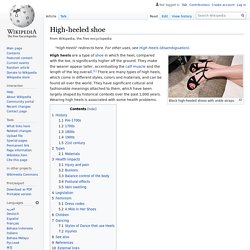
High heels are a type of shoe in which the heel, compared with the toe, is significantly higher off the ground. They make the wearer appear taller, accentuating the calf muscle and the length of the leg overall.[1] There are many types of high heels, which come in different styles, colors and materials, and can be found all over the world. They have significant cultural and fashionable meanings attached to them, which have been largely shaped by historical contexts over the past 1,000 years. Wearing high heels is associated with some health problems. History[edit] Pre-1700s[edit] 21st-century cowboy boot – illustrating the unchanging shape of a horseback riding shoe European heeled shoes from ca. 1690 High heels have a long history, dating as far back as the tenth century. 1700s[edit] Typical 18th-century shoe 1800s[edit] 1900s[edit] 21st century[edit] Types[edit]
The Great French Mustache Strike of 1907. It’s April 1907. You’re an American in Paris, searching for a taste of real culture—maybe in the form of some fine French cuisine. You settle down in a quaint café, but before you can choose between the pissaladière and the pâté en croûte, a police officer approaches and asks you—not exactly politely—to leave. As he tells you to “Sortez!” He gestures at his mustached upper lip. You, clean-shaven, stagger off, confused and hungry. Around the city at that time, high-end waiters were on strike to demand better pay, more time off—and the right to grow mustaches. Those who stayed were treated as those considered scabs often are—berated by strikers who wanted them to join the movement.
BBC - History - British History in depth: The Hidden Story of Partition and its Legacies. Www.1947partitionarchive.org. A history of music and technology. The Strange Tale of the Great 1911 Trans-Saharan Ostrich Heist. Open Heritage. 5 Objects That Illuminate the Medieval Exchange Between Africa and Europe. Bros and Rows: The Real History Of Men Who Knit. True or false: The multi-million dollar knitting industry is the domain of grandmas and craft circles with names like Stitch ‘n’ Bitch.

Right? Boy, are you wrong. Macho men — not women — dominate the history of the craft. Today, U.S. and U.K. news stories pop up about men who knit while in maximum-security prison. Men who knit while riding public transportation to work. But the birds-eye view reveals that men ruled knitting for centuries, got side-tracked, and now are finding their way back to the knitting needles. Here’s one story — or at least a close approximation of it. About 200 A.D., Arabian men were fishing for food but they had no way to catch several fish at once.
Returning looted artefacts will finally restore heritage to the brilliant cultures that made them. European museums are under mounting pressure to return the irreplaceable artefacts plundered during colonial times.
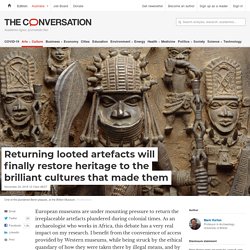
As an archaeologist who works in Africa, this debate has a very real impact on my research. I benefit from the convenience of access provided by Western museums, while being struck by the ethical quandary of how they were taken there by illegal means, and by guilt that my colleagues throughout Africa may not have the resources to see material from their own country, which is kept thousands of miles away. Now, a report commissioned by the French president, Emmanuel Macron, has recommended that art plundered from sub-Saharan Africa during the colonial era should be returned through permanent restitution.
The Great Binge. The Great Binge is a 21st Century neologism, coined by amateur historian Gradus Protus van den Belt, describing the period in history covering roughly 1870 to 1914.[1] It is so known because of the widespread use and availability of narcotics such as opium, heroin, cocaine, morphine, and absinthe.[1] During this period these drugs were widely available and incredibly popular among both men and women of many social classes in many parts of the world.[1] They were marketed to both adults and children, often included in patent medicines such as cough syrups, pain relievers, and asthma medicines.[2] They were administered to infants and women with menstrual cramps, and included in food and beverages such as Coca-Cola.[2] Literary characters such as Sherlock Holmes were portrayed using morphine and cocaine.[1] Holmes is described as having a particular penchant for overt injections of a 7% solution of cocaine - though only when lacking adequate mental stimulation.

The Great Binge (1870 - 1914), page 1. I recently came across a thread on ATS entitled; 1914 - The Year the World Went Mad.
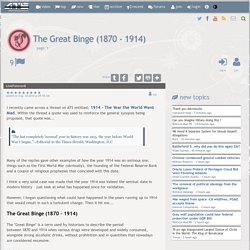
Within the thread a quote was used to reinforce the general synopsis being proposed, that quote was... “The last completely ‘normal’ year in history was 1913, the year before World War I began.”
—Editorial in the Times-Herald, Washington, D.C Many of the replies gave other examples of how the year 1914 was an ominous one, things such as the First World War (obviously), the founding of the Federal Reserve Bank and a couple of religious prophesies that coincided with this date. I think a very solid case was made that the year 1914 was indeed the seminal date in modern history – just look at what has happened since for validation.
The Century-Long Scientific Journey of the Affordable Grocery Store Orchid. Wholesale orders go out today at Waldor Orchids, and the front room is filled with daubs of pink, purple, and orange, sweeps of peach, yellow splotches splattered with blood-red droplets, palettes of lavender fading into white.

“This order here is a real basic order,” says Dave Off, picking a scrawled slip off the wall. Here in the greenhouses his grandfather built by the bay in Linwood, New Jersey, there are plants that have been alive for more than 100 years and plants that were born 18 months before in test tubes in Florida. That “basic order” means two large pots, with four phalaenopsis orchid plants apiece, two facing forward and two doubles—each with a pair of flower-bearing, stem-like spikes—turned towards the side. When they’re in bloom, phalaenopsis spikes (or inflorescences, as they’re also known) curve gently under the weight of an elegant row of flowers.
The Great French Mustache Strike of 1907. Antisemitism in History: From the Early Church to 1400. Sometimes called "the longest hatred," antisemitism has persisted in many forms for over two thousand years.

The racial antisemitism of the National Socialists (Nazis) took hatred of Jews to a genocidal extreme, yet the Holocaust began with words and ideas: stereotypes, sinister cartoons, and the gradual spread of hate. In the first millennium of the Christian era, leaders in the European Christian (Catholic) hierarchy developed or solidified as doctrine ideas that: all Jews were responsible for the crucifixion of Christ; the destruction of the Temple by the Romans and the scattering of the Jewish people was punishment both for past transgressions and for continued failure to abandon their faith and accept Christianity.
Seeking to retain their beliefs and culture, Jews became bearers of the only minority religion on a now Christian continent of Europe.
Nikola Tesla Built a Giant Tower to Send Wireless Electricity Around the World. Pictures of The Global Conflict of World War I ~ vintage everyday. At the start of the war, the largest of the European belligerents were all colonial powers -- they had people and valuable assets stationed in countries all over the Earth.
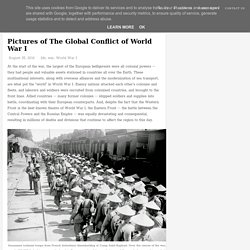
These multinational interests, along with overseas alliances and the modernization of sea transport, are what put the "world" in World War I. Enemy nations attacked each other's colonies and fleets, and laborers and soldiers were recruited from colonized countries, and brought to the front lines. Allied countries -- many former colonies -- shipped soldiers and supplies into battle, coordinating with their European counterparts.
Titanic 100 years in 3D/ Титаник: 100 лет в 3D. Titanic Real Story - New Documentary 2018 - BBC Documentary. Seen from the air, the dry summer reveals an ancient harvest of archaeological finds. For an aerial archaeologist 2018 has been a bumper year.
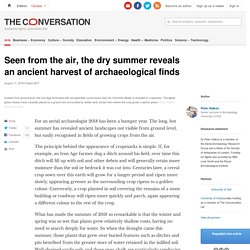
The long, hot summer has revealed ancient landscapes not visible from ground level, but easily recognised in fields of growing crops from the air. The principle behind the appearance of cropmarks is simple. If, for example, an Iron Age farmer dug a ditch around his field, over time this ditch will fill up with soil and other debris and will generally retain more moisture than the soil or bedrock it was cut into. Centuries later, a cereal crop sown over this earth will grow for a longer period and ripen more slowly, appearing greener as the surrounding crop ripens to a golden colour.
New Series: Last Witness – PRXOfficial. For many years I’ve kept a folder by my desk labeled: “Too Late Stories.”

It’s full of newspaper clippings and obituaries about people I would have loved to interview, but I was too late. People like Mark Matthews, the last of the legendary Buffalo Soldiers.
Persephone. Persephone as a vegetation goddess and her mother Demeter were the central figures of the Eleusinian mysteries that predated the Olympian pantheon and promised the initiated a more enjoyable prospect after death. Persephone is further said to have become by Zeus the mother of Dionysus, Iacchus, or Zagreus, usually in orphic tradition. The origins of her cult are uncertain, but it was based on very old agrarian cults of agricultural communities. Name[edit] Etymology[edit] Persephone or "the deceased woman" holding a pomegranate.
11 Forgotten Media Formats of Yesteryear. Kaliningrad: the unique World Cup city that has twice tried to erase its past.
Kaliningrad and its new US$300m “Arena Baltika” stadium has been thrown into the spotlight by the football World Cup. But will the city’s latest project finally succeed in eclipsing its pre-war German history? Nestled between Lithuania to the north and east, Poland to the south, and the Baltic Sea to the west, Kaliningrad is today an “exclave” of Russia. But the region was once at the centre of European history and culture. Founded by the Teutonic knights in 1255, Königsberg or “King’s Mountain” – as Kaliningrad was once known – first developed as a Hanseatic commercial centre, and was made rich through trade in people, goods, and ideas.
Saint Cecilia. While the details of her story appear to be fictional[citation needed], her existence and martyrdom are considered a historical fact[citation needed]. She is said to have been beheaded with a sword. An early Roman Christian church, Santa Cecilia, was founded in the fourth century in the Trastevere section of Rome, reputedly on the site of the house in which she lived.
A number of musical compositions are dedicated to her, and her feast day has become the occasion for concerts and musical festivals. Life[edit] St. Saints Cecilia, Valerian, and Tiburtius by Botticini. 8 defunct airlines we want to fly again. Image It's no secret that air travel has lost its romantic allure. The waits are longer, the leg room is less roomier, the food isn't free, and when was the last time a pilot pinned little metal wings to your shirt? The 1960s were the golden age of air travel, when planes were more akin to hotels in the air, not buses, and roast beef was carved in the aisle.
It was stylish. Even the uniforms were designed by European fashion houses.
Guy jones. Bearing witness to Cambodia’s horror, 20 years after Pol Pot’s death. Millions of historical images posted to Flickr. An American academic is creating a searchable database of 12 million historical copyright-free images. Kalev Leetaru has already uploaded 2.6 million pictures to Flickr, which are searchable thanks to tags that have been automatically added.
Oldest message in a bottle found on Western Australia beach. Image copyright kymillman.com A Perth family has found the world's oldest known message in a bottle, almost 132 years after it was thrown into the sea, Australian experts say.
Tonya Illman picked up the bottle while going for a walk around sand dunes on a remote beach in West Australia.
In 1848 A French Commune Built an Interconnected Treehouse Cabaret Based on Swiss Family Robinson. History on the Net. @BBnowandthen - Recherche sur Twitter. The Rock Solid History of Concrete. The story of concrete is so ancient that we don't even know when and where it begins. It is a story of discovery, experimentation, and mystery. Emperors and kings became legends for erecting great concrete structures, some of which are still a mystery to engineers today.
RIP Stanislav Petrov: Russian colonel who saved world from all-out nuclear war.
Quiet hero dies at 77 Not all heroes wear capes – some wore Soviet uniforms ...
BBC - Andrew Marr: The Making of Modern Britain 720p (Part 1 of 6)
History of the cooperative movement. Memory of the World. BBC Four - Jerusalem: The Making of a Holy City. Food Preservation History: Here Explained Fully with Timeline. Food preservation has been followed in all cultures at different points in time. Nature had to be harnessed for man to survive.
History of Chess - Chess.com. History of chess - Wikipedia. Bettanyhughes. Hidden Histories - WW1's Forgotten Photographs (2014)
The birth of Israel. The Birth of Israel. Salt March - Facts & Summary. In Ancient Warfare, Both The Greeks And Romans Fought Off War Elephants With?
WikiLeaks War Diaries. Science and inventions of Leonardo da Vinci - Wikipedia. The World's Most Dangerous Colors. BBC World Service - 50 Things That Made the Modern Economy - Downloads. Shock and Awe: The Story of Electricity. Julia Galef: Why you think you're right. Bizarre Underwater Discoveries. 15 Greatest Weapons That Never Saw Action. 14 Strangest Things Found in American Deserts. 12 Unique Abandoned Places. 10 Scary Abandoned Places You Shouldn't Explore.
BBC Radio 4 - The Ideas That Make Us. Ray Mears Goes Walkabout - John McDouall Stuart. Piers Secunda - Painting Of A Puzzle Ball. The Great Binge: Heroin, Cocaine and Opium Over the Counter. Yom Kippur War – Battle of Golan Heights. Animated interactive of the history of the Atlantic slave trade.
Héloïse Biography - life, family, childhood, children, name, story, history, wife, school, mother. ...Louis Braille Biography...
Palmares (quilombo) - Wikipedia. Simply... The History Of Borders. Walter Hunt Invented the Safety Pin and a Sewing Machine. The Voynich Manuscript. National Geographic. College Museum of Ancient Inventions: Baghdad Battery. Google Cultural Institute. Project Mosul. The Judas Gospel. Pencil Museum. Jon Mooallem: How the teddy bear taught us compassion. Why I hate History ( the reasons and their reasons).
International Institute for Conservation of Historic and Artistic Works. BBC Four - The Secret Life of Rubbish - Episode guide.
The Oriental Institute of the University of Chicago. Greece profile - Timeline - BBC News. Retronaut. The Roaring Twenties. Dennis Severs' House - 18 Folgate Street. The History of Cartography Project. The History of Sound Recording Technology. Current Archaeology.










